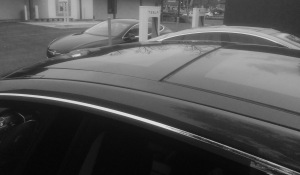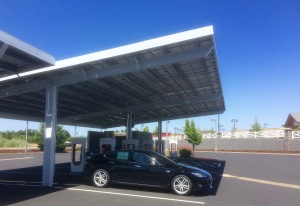Preface
For this article, my standard photo sharing uses on this website DO NOT APPLY. These photos are under copyright by Tesla Owner and cannot be used elsewhere. More details in the appendix.
Introduction
Recently many California Tesla owners and I were invited to participate in the battery swap. I could not resist trying it out. I had a couple of upcoming plans in Southern California, and arranged a four day trip including a battery swap at the Harris Ranch Battery Swap Station in Coalinga, California off Interstate 5 (I-5).
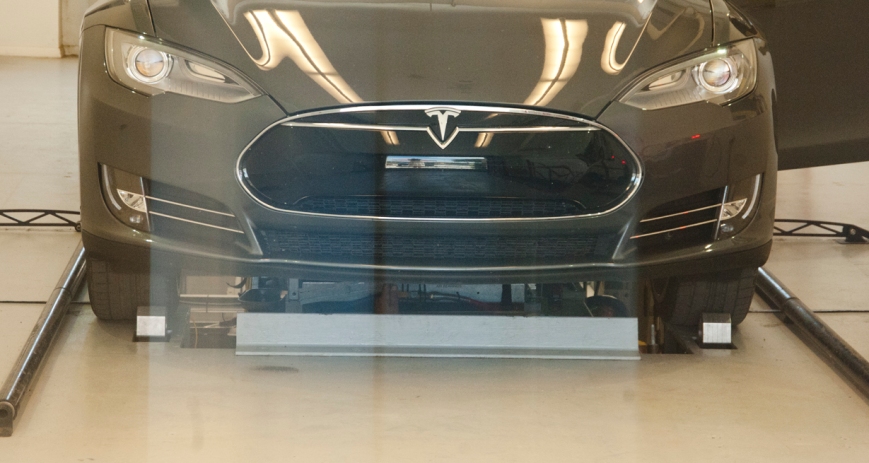
©Tesla Owner 2015 — Car Undergoing a Six Minute Battery Swap in Coalinga, CA
This blog post will describe in detail the logistics of the swap. Then I provide some analysis of the viability of battery swap stations.
Scheduling a Swap
To schedule a swap, you call a Tesla employee who lives in Coalinga. The swaps are available seven days a week from around 9am to 5pm. He fits you into an available time slot. When I called, the swap station was already quite booked for the next couple of weeks. I managed to schedule a trip by driving down on a Friday and returning on a Monday. No slots were available on the weekend and only two slots were available on that Monday. The station appears to be quite busy for the foreseeable future.
Currently, the majority of people using the swap are folks driving on business. They are probably traveling salesmen who need their car or our visiting a variety of locations. Because for most business trips, traveling between San Francisco and Los Angeles areas is better served by airplanes.
Although you need to make an appointment, the appointment time is not fixed in stone. If you arrive one hour late, it is “no big deal”. He does prefer you call in transit to let you know an approximate time of arrival. Part of this courtesy call is that there are several people working underground to get the battery off and on. If he knows when you are to arrive, they can be in position to make the swap faster.
Your travel plans need to be a true round trip. Your need to return to the same location to pick up your battery.
The cost of the swap is $80 for both swaps. The price is comparable to two tanks of gas for a large vehicle. You will get the same type of battery that you already have on your car: 60, 70 or 85 kWh. The battery I got during the swap was not a new battery but actually the same B vintage. The battery will be fully range charged upon your arrival.
The Swap Itself
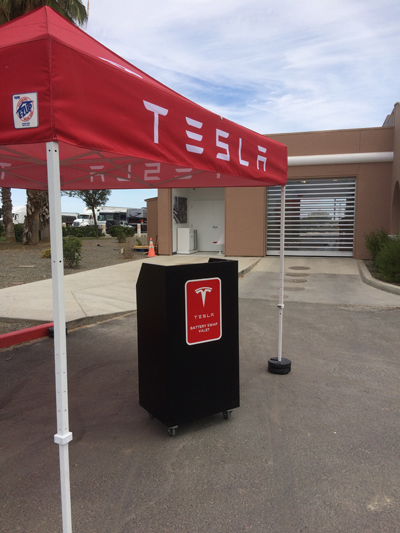
©Tesla Owner 2015 — Valet Station at Tesla Battery Swap
The swap itself is very simple. You arrive at the south end of the station, where a Tesla employee greets you. He intentionally take the fob and hands it back to you at the end, because one customer accidentally drove off without his fob. The valet then drives your car to the north end and into the swap station. They close all the doors at this time.
There is a funky waiting room to the side with a couple of chairs and a LCD screen with four security camera like scenes. You can’t see much of anything useful in this room. They have a refrigerator with chilled plastic bottled water, but I’d prefer to see a chilled water dispenser to refill my reusable stainless steel and BPA free water bottles.
The better view is by watching it through the back door. The door is a mixture of a clear material and a metal. You can see the process much better by peering through the slats. If they did not want you to watch this process, they could have easily installed a solid door.
All three of these spots are visible in the picture to the right. The black valet station is in the foreground, the funky white waiting room immediately behind it, and the battery swap station with its see through slats.
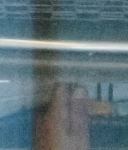
©Tesla Owner 2015 — Requires Humans
The car is driven on a floor that is removable. Workers underneath unscrew the existing battery. A mechanical machine moves the old battery out of the way and brings a new battery into position, and then it is screwed on by the workers.
Even by peering through the back door of the station, it is quite difficult to see much of anything going on inside as it is all taking place under the car. I did see a few hands, so I know the process is not completely automated.
While this process is occurs, the valet cleans your windshield and front lights.
Swap Time
The swap itself took 6 minutes the first time, and 8 minutes the second time for an average of 7 minutes. On the demonstration video back in 2013, the car was swapped in 1 1/2 minutes. The second time they had a minor issue putting in my battery. They seemed to need to pull it back and readjust it. The 7 minute average time was from when I handed the valet the fob to when the car exited the swap station.
Using Someone Else’s Battery
Batteries wear down with more use. So on this trip for 971 miles, my battery stayed in Coalinga. An weak analogy exists between driving a rental car and driving on a swapped battery. But other than range charging every time and driving a lot of miles it is hard to abuse a battery. An extreme situation would be to arrange a battery swap and then drive the car around the country for 10,000 miles and then return a month or so later to get your own battery.
Trip Energy Report
The following information is primarily just amusing. I drove from home, swapped the battery in Coalinga and did not charge till I reached the Mojave supercharger. When you do a swap, the software does not know the battery has changed and reports the following information.
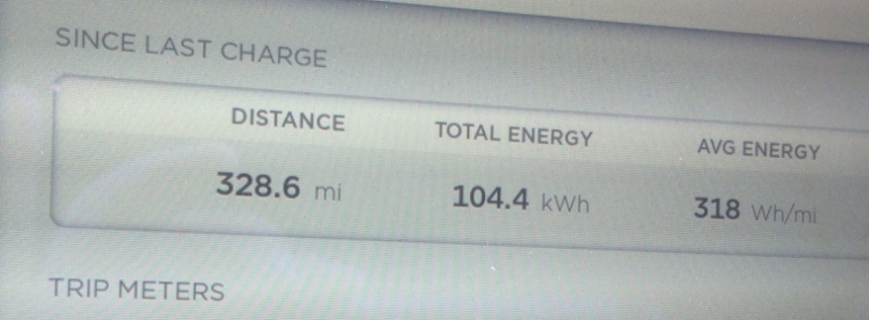
Trip Energy Shows 104.4 kWh Since Last Charge
I had used 104.4kWh to get from home to the Mojave supercharger! I would love to have a battery with more than 100kWh.
Swap Station Interest Level
At the 2015 Shareholder’s Meeting, Elon stated that there is not that much interest in battery swapping.
“We have, basically, the LA-to-San Francisco pack swap capability in place, and I believe all Model S owners in the California area have been invited at this point to try it out. And what we’re seeing is a very low take rate for the pack swap station. So we did an initial round of invitations, where we did basically, like, 200 invitations, and I think there were a total of four or five people that wanted to do that, and they all did it just once. So, like, okay, clearly it’s not very popular. And then we said, okay, let’s expand that invitation to all customers, but I would expect that all customers behave roughly like that initial sample group.”
This statement from Elon is a bit misleading. First of all not that many people drive from San Francisco to Los Angeles routinely. People that can afford a Model S are more likely to fly. So if they only got a 2% result from their invitation, that would not be surprising given the demographics. Secondly for those of us who are fond of driving, we are not that likely to do this drive regularly. I have driven on I-5 now twice this year, and I know I will be doing it again next February but have no plans in between those two dates. Leisurely drivers may also opt to drive on highway 101, which is more scenic. So it does not surprise me at all that the swappers only swapped once. If it is true that the Beta testers only swapped once but drive regularly up and down I-5, that fact would be much more convincing. But the swap station appointment calendar is currently quite busy.
“It’s just, people don’t care about pack swap. The Superchargers are fast enough that if you’re driving from LA to San Francisco, and you start a trip at 9 AM, by the time you get to, say, noon, you want to stop, and you want to stretch your legs, hit the restroom, grab a bite to eat, grab a coffee, and be on your way, and by that time, the car is charged and ready to go, and it’s free. So, it’s like, why would you do the pack swap? It doesn’t make much sense.”
In general, I agree with this part of Elon’s statement. But I can drive from San Francisco to LA on two range charges. I can range charge at home, reach Coalinga, swap and make it to my destination in the north half of Los Angeles. If I need to stop and do a range charge, my charging time is much closer to an hour. I may want to grab a very fast bite and be out of there in fifteen minutes. I don’t always want to eat or stretch my legs exactly the time I arrive at a supercharger, so more flexibility is nice.
I also tend to not drive on the obvious routes. On this trip, I first went to the desert and drove from Coalinga towards Barstow, but I did need to stop in Mojave to charge for a few minutes before continuing. According to EVtriplanner in hot conditions starting in Coalinga, the drive to Tejon Ranch, Mojave and Barstow superchargers would take 47.4, 63.7 and 87.1 kWh respectively. Ideally I would like to skip both Tejon Ranch and Mojave and make it all the way to Barstow. I don’t really mind stopping and supercharging, but on very long drives it is really nice not to have to stop, or to shorten the charging time significantly. I have previously driven directly to Mojave on a non-range charge but I drove a bit conservatively. With a full range charge, I can drive worry free.
Returning back up north from Coalinga, if I do not have a range charge, I need to stop at the Gilroy supercharger. I potentially may be able to make it home if I am very careful but I could definitely not stop by for an errand or two. After using the swap I easily made it home about thirty minutes to an hour earlier because saving time charging. I could have range charged for an hour in Coalinga, or I could have saved some time by charging both in Coalinga and in Gilroy. But sometimes one simply does not want to negotiate getting on and off the freeway. I felt my $80 was well spent for these two long driving days.
On the other hand if the swap station was not available, I would be content with supercharging for free.
Where Battery Swaps Make Sense
I think there are a few places where battery swaps make sense. Here are the parameters:
- A long highway with nothing interesting to see, do or eat.
- The start point from home to the swap can be done on a range charge but challenging on a regular 90% charge.
- From the swap to the end point can be done on a range charge but challenging on a 90% charge.
So in California, I would envision the three following routes that could perhaps support a battery swap station:
- The existing Coalinga / Harris Ranch along I-5 between San Francisco and Los Angeles.
- Perhaps a station near Davis, CA serving skiers, boarders and other folks heading to Lake Tahoe or the Sierras for the weekend from the San Francisco area. This location would be somewhere along I-80 before the split with 50 in order to serve both shores of the lake.
- Somewhere between Los Angeles and Las Vegas.
Swap Station Viability
The physical footprint of the swap station is larger than a supercharger station and has only one use. The Coalinga swap station formerly had been a car wash. There needs to be enough physical space to store enough batteries in order to have enough swaps. This physical space has a more real cost than a supercharger in a standard parking spot in the United States.
I only interacted with the Tesla valet, and could not clearly see the other Tesla employees that were underground. I know there were at least two and most likely three employees underground. So to keep a swap station viable, there needs to be enough swaps per day to pay for a head count to run the swap station.
Appointments
The current scheme to use the swap requires appointments. Although they are open 7 days a week, the 9am to 5pm schedule is a bit limiting. When taking trips it is often difficult to plan the exact time frame when arriving at a destination.
I can easily envision the two additional routes mentioned above (Lake Tahoe and Las Vegas) being primarily used for weekend jaunts. The timing for swaps would likely be Friday between 5 and 9 pm and Sunday between 4 and 8 pm. The current 9am to 5pm schedule would not really be very useful for true weekend get aways.
A true useful swap station would not be this restrictive. Perhaps you are guaranteed a fast swap if you have an appointment, but if you do not, you may have to wait. The Coalinga station will remain in operation through at least early 2016.
Conclusion
“We built the pack swap into the car because we weren’t sure if people would want to choose the pack swap or not. We thought people would prefer Supercharging, but we weren’t sure, so that’s why we built the pack swap capability in. And, you know, based on what we’re seeing here, it’s unlikely to be something that’s worth expanding in the future, unless something changes.”
I don’t think the battery swap stations need to be widespread. When on a true leisurely vacation, one enjoys stopping and absorbing the local color. But on routine drives, $80 is not a lot of money. I remember many weekends driving up to go skiing, and saving those 30 minutes of charge time would have been great, and I could envision easily splitting the cost amongst everyone in the car instead of chipping in for gas money.
I can envision in the future if the economics work out well enough for Tesla, there will be say a dozen swap stations in the United States on heavily used corridors. I do agree with Elon that there is not a large demand for swap stations in general because for most drives supercharger times are fast enough.
My final review is that I appreciated the swap station. I don’t like I-5 and I just want to keep on driving. The process worked smoothly but I did feel a bit restricted by the requirement of an appointment. Unless the logistics of the swap station could financially support a non-appointment model, I don’t think swap stations will be very popular outside of a few locations.
Appendix
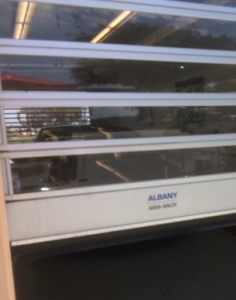
©Tesla Owner 2015 — Rollup Doors with Visibility
When I arrived at the swap station, I asked if it was okay to take pictures. I was informed that it was fine for personal use. There is no signage restricting photos or any information to that effect in any of the correspondence on the swap. I told the valet that I was a blogger, but that I do not make money on the blog. So would that be a problem as this is a personal blog? He did not clarify the statement but directed me to call Tesla media relations.
I wanted to give Tesla the fair opportunity to say no, so I called Tesla and asked for media relations. They told me to send an email to a particular email address. I described what I was going to do and introduced myself and asked permission to post photos of my battery swap. I only received an automated reply. One business day later but three actual days later, I again sent an email to Tesla saying I was going to publish the photos soon unless they had a problem with that and to please let me know. Since I made my best effort to contact Tesla and have now waited over three business days, I decided it was okay to publish these photos but will not share them with other websites.
I am not particularly impressed with how Tesla handles these kinds of questions. I should be able to get a response by phone or email within a few days. And if they have any real concerns about people using these photos, they need to inform their own employees the exact policy.






